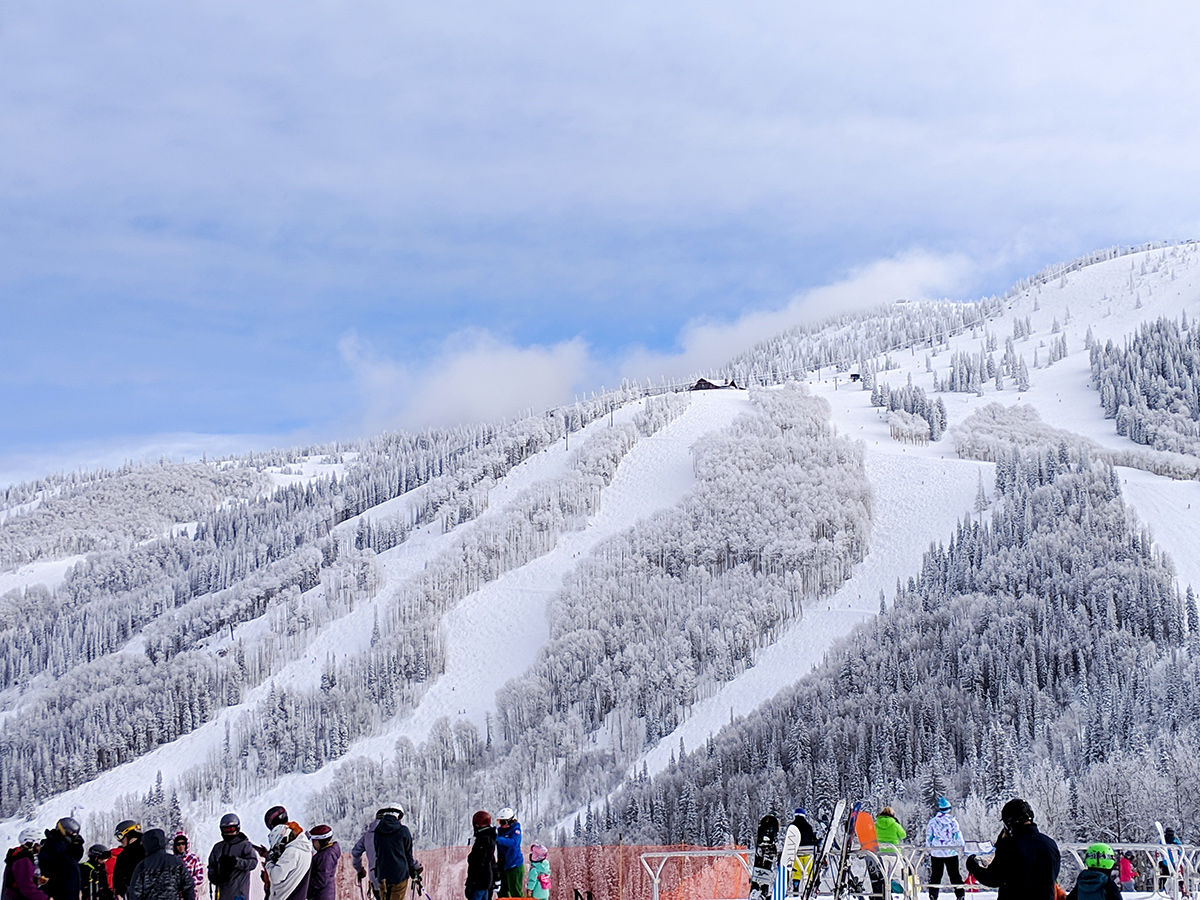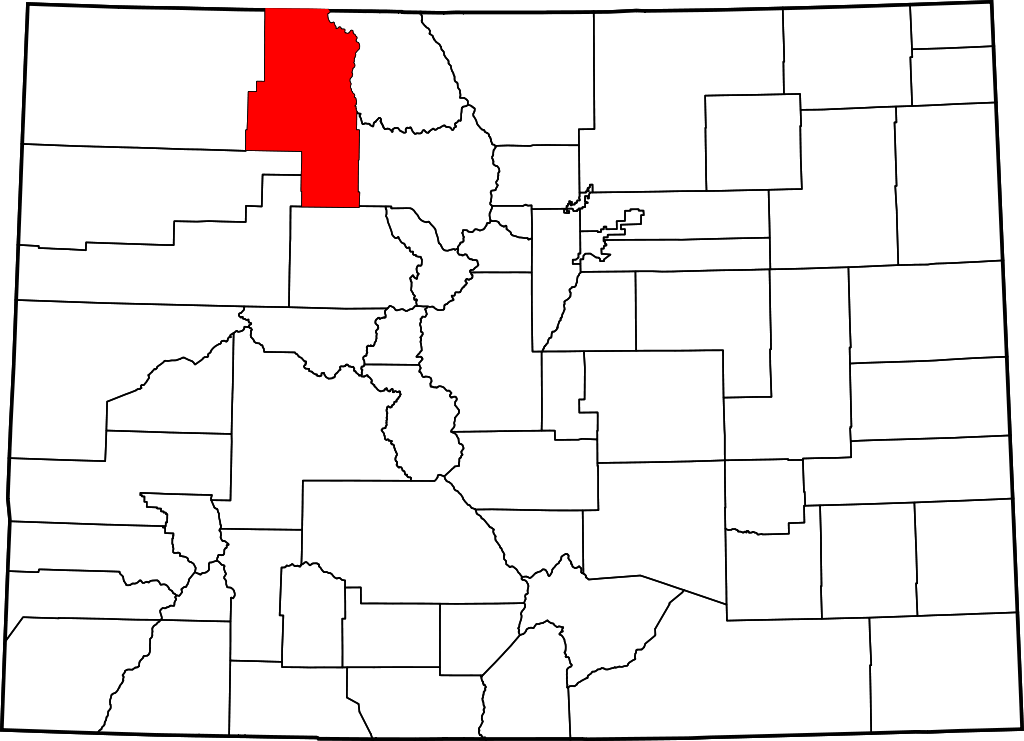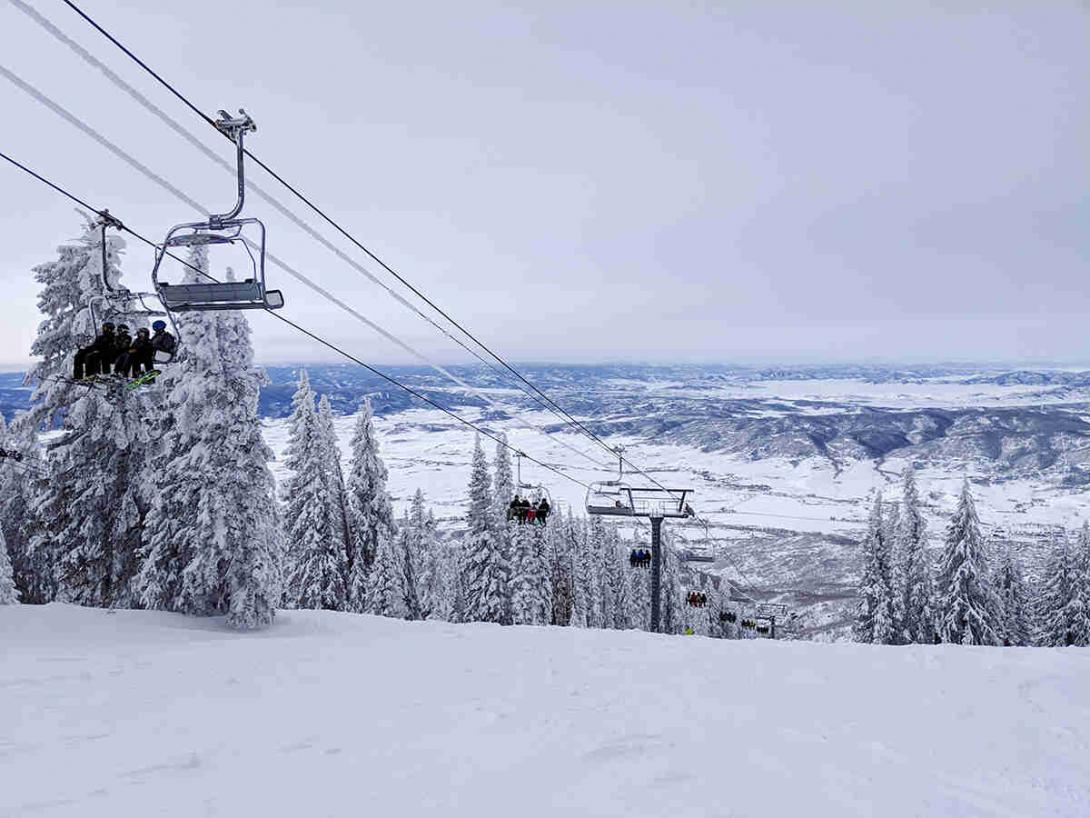Routt County
Full Article
Routt County is a large county in northwest Colorado, encompassing 2,368 square miles of the Elk and Yampa River valleys and the Park Range and Elkhead Mountains. It is bordered by the state of Wyoming to the north, Jackson and Grand Counties to the east, Eagle County to the south, and Rio Blanco and Garfield Counties to the southwest.
 Routt County has a population of 24,130. Steamboat Springs, the county seat and largest city, lies in the Yampa valley along US Hwy 40 and is one of the state’s most popular ski destinations. Farther upstream, Colorado State Highway 131 connects the communities of Oak Creek and Yampa. Downstream from Steamboat Springs, the Yampa flows through pasture- and farmland and the communities of Milner and Hayden. Yampa Valley Regional Airport, near Hayden, provides seasonal air service to various parts of the country and year-round service to and from Denver.
Routt County has a population of 24,130. Steamboat Springs, the county seat and largest city, lies in the Yampa valley along US Hwy 40 and is one of the state’s most popular ski destinations. Farther upstream, Colorado State Highway 131 connects the communities of Oak Creek and Yampa. Downstream from Steamboat Springs, the Yampa flows through pasture- and farmland and the communities of Milner and Hayden. Yampa Valley Regional Airport, near Hayden, provides seasonal air service to various parts of the country and year-round service to and from Denver.
Historically, the Routt County area was home to nomadic Ute Indians before the mid-nineteenth century, when gold discoveries near Hahn’s Peak, above the Elk River valley, attracted white prospectors. Ranchers and farmers followed the miners, taking advantage of the area’s fertile river valleys. Routt County was established in 1877 and named for then governor John L. Routt, the first governor of the State of Colorado. The county assumed its current size after the creation of Moffat County in 1911.
Native Americans
The mountains and river valleys of present-day Routt County have a long history of human occupation, dating back to the Paleo-Indian period of nearly 11,000 years ago. Back then, indigenous hunter-gatherers quarried stone for tools at Windy Ridge, which overlooks the divide between North and Middle Park in what is now southeast Routt County.
During the warmer months, the Yampa and Elk valleys drew large amounts of game, including elk, mule deer, and bison. These animals provided the core sustenance for indigenous peoples from the Paleo-Indians of thousands of years ago through the Yampa Utes, who began living in the area by the fifteenth century AD. The Yampas (also known as Yamparikas or Yampaticas) derived their name from the Yampa plant, which has an edible root not unlike a water chestnut. The plant was a staple part of the Utes’ nonmeat diet.
Like earlier native peoples, the Utes were hunter-gatherers who followed a seasonal circuit between the high and low country. They spent summers hunting game in the mountains and returned to lower elevations and the shelter of river valleys for the winter. The Utes were also well acquainted with the mineral-rich hot springs near present-day Steamboat Springs, which they visited often to revive both body and spirit. Utes lived in temporary or mobile wooden dwellings, such as wickiups and tipis. The Yampa Utes traveled widely during the year, ranging west into Utah, north into Wyoming, and east to North Park.
Early American Era
The United States acquired the Routt County area as part of the Louisiana Purchase in 1803, though it remained officially unexplored until beaver trappers arrived in the 1820s. One of these early trappers allegedly provided the inspiration for the name of Steamboat Springs, likening the sound of the springs’ water to that of a chugging steamboat. In 1843 and 1845, American explorer John C. Frémont, guided by trapper-turned-scout Kit Carson, traversed the Routt County area to survey a possible railroad route. No route was found, however, and demand for beaver pelts fell off by the 1840s. Irish hunter George Gore followed a Ute trail over what is now Gore Pass in 1855, but white interest in the Yampa valley and the rest of present Routt County largely subsided until the Colorado Gold Rush of 1858–59.
In 1862, a year after Congress created the Colorado Territory, German immigrant Joseph Hahn and two other prospectors headed west from Georgetown in search of the next big gold strike. They made their way over Gore Pass into the Yampa valley and continued up the Elk River, where they found gold in a stream at the base of Hahn’s Peak. The onset of winter forced the group to head back east. Hahn returned to the area with another party in 1865, panned for gold, and again left before winter.
In summer 1866, Hahn brought a third group to the site. Despite an attack by Utes, who killed some pack animals and made off with some of their possessions, the men panned out a decent amount of gold. This time, Hahn and two of his companions—William Doyle and George Way—decided to stay for the winter. In October Way left to get supplies but never returned. After making it through the winter with almost no provisions, Hahn and Doyle began a desperate snowshoe trek toward Empire. The starving men made it as far as Middle Park, where Hahn died and local residents rescued Doyle.
About a year after Hahn met his fate, the federal government brokered the Treaty of 1868, which transferred all Ute lands east of the Continental Divide, as well as the Yampa River valley, to the United States. In return, the Utes were given a large reservation on Colorado’s Western Slope and promised annual payments and supplies, which they would receive at various agencies built throughout the reservation. Having lost the valley that bears their name, the Yampa Utes were to report to the White River Agency near present-day Meeker.
As the Yampa Utes struggled to adjust to life on the new reservation, American geologist Ferdinand Vandeveer Hayden led a surveying expedition through present-day Routt County in 1873. Hayden’s expedition identified major coal deposits in the Yampa valley, but those deposits would not receive much attention until it was certain the region did not have a future cast in gold.
In 1874 several companies expanded on Hahn’s modest mining operations near Hahn’s Peak. In 1875 Chicagoan J. V. Farwell made a considerable investment in the area, building a toll road from Laramie, Wyoming, and setting up a sawmill and a store. The mining settlement took the name Hahn’s Peak Village. Since the area was originally included in several different counties, it is difficult to determine exactly how much gold the Hahn’s Peak district produced, but it was apparently enough to stimulate further development in the area.
County Development
While miners pulled gold out of the Hahn’s Peak district, several settlements were developing in the Yampa River valley. James H. Crawford, a prospective homesteader from Missouri, arrived in the summer of 1874 and was immediately smitten by the valley’s beauty. Crawford built a cabin where the Yampa begins its westward bend, near natural springs that gushed into verdant meadows. Like the prospectors before him, Crawford had to leave the remote valley before the winter snows hit, but he returned the following summer with his family.
Over the next few years, the Crawfords lived in friendship with the Yampa Utes, who often camped near the springs and traded with the family. The Crawfords’ cabin became the hub for a small community of white settlers, serving as the area’s first post office, school, and church. In 1884 James Crawford organized the Steamboat Springs Town Company, which platted the town and built the first bathhouse around the springs.
In 1873 veteran explorer Colonel Porter Smart located the site of present-day Hayden, naming it for the surveyor who had passed through the area in 1871. One of the first to arrive in Hayden in 1874 was Porter's son Albert and his family, along with his brother Gordon and a number of others, such as Thomas Isles, who were part of the Bear River Colony. Albert Smart established the Hayden post office in 1875 at his homestead near the Yampa River. In 1876 JB Thompson, a former Indian agent, brought his family to the valley and established a trading post near the Smarts.
When Routt County was established in 1877, Hayden was appointed the county seat because it was in the center of the new county, whose boundaries extended westward to the Colorado-Utah border. J.B. Thompson served as the County Clerk until a countywide election could be held. The town of Hahn's Peak was chosen in the next election. Hahns Peak proved too remote, however, so in 1912 residents voted to move the county seat to Steamboat Springs.
Rancher Preston King settled with several other people near present-day Toponas in 1878. But the county’s main influx of white immigrants began after the Utes were forcibly removed to Utah in 1880. That year, cattleman A. W. Salisbury began a workhorse ranch in the Hahn’s Peak area in partnership with boardinghouse operator Bob McIntosh. With the help of one of his five brothers, Charlie Temple drove 1,500 cattle into the Yampa valley in 1884 and acquired a ranch near Hayden. In 1886 the Laughlin family homesteaded near present-day Yampa and Charley Honnald established what is now the Focus Ranch, along the Snake River near the Wyoming border.
The arrival of these early ranchers demonstrated to the rest of Colorado what the Utes had known for generations: the meadows watered by the Yampa and its tributaries were ideal for supporting large herds of grazing animals—except now those animals were domesticated cows instead of wild bison. By 1890 the US Census of Agriculture reported that “cattle raising is the principal industry” of Routt County and “the greater part of the water” from irrigation ditches was “used for hay and meadow lands.”
Coal Mining
In 1910 Routt County had more than 94,000 head of cattle, but ranching was not the only lucrative industry in the area. In 1908 the Union Pacific Railroad reached Steamboat Springs via the Moffat Road, finally allowing coal, cattle, and farm products to be shipped throughout the state and the nation. With rail access, the economic and population center of the county shifted decisively from the Elk valley to the Yampa valley, and Steamboat Springs was named the new county seat in 1912. The railroad also brought a new wave of settlers, and the Routt County population increased from 3,661 in 1900 to 7,561 in 1910.
Coal mining in particular required an efficient means of transport before it could be a major industry in the county. In 1892 a US Geological Survey study confirmed large bituminous coal deposits near Oak Creek, Twentymile Park, and most of western Routt county, along with anthracite coal deposits in the California Park area. Before the arrival of the railroad, several dozen small coal mines operated in Routt County, providing fuel for local ranchers and farmers. But once companies knew a railroad was on its way, they began buying up these smaller mines in preparation for larger operations.
Following the county’s shift toward corporate coal, Sam Bell, John Sharpe, and D. C. Williams—all businessmen from Cripple Creek—organized the Oak Creek Town, Land and Mining Company in 1907. They platted Bell Town, later renamed Oak Creek, and by 1915 the town was home to more than 2,000 people, mostly coal miners and their families. Other coal mines and mining towns could be found in the towns between Milner and Hayden, along what is now US 40 - MacGregor, Coal View, Bear River, and Mt. Harris.
Like other coal miners in Colorado, Routt County miners labored in dark, hazardous environments for ten to twelve hours per day, receiving only meager wages in return. Fully aware that their labor kept Colorado’s economy going, many joined unions such as the United Mine Workers of America (UMWA) to lobby for better pay and working conditions. In 1913 more than 400 Routt County coal miners joined a statewide strike that ended only after martial law was declared. Coal mining continued throughout the twentieth century; by the 1960s, most coal came not from mine shafts but from strip mines, created by heavy machinery moving tons of earth to expose coal deposits.
Skiing and Tourism
Rails shipped coal out of the county, but they also brought in tourists, another valuable part of the local economy. Despite snow sheds and snowplows, early passenger travel along the Moffat Road was fraught with danger, as the railroad’s route over the Continental Divide often sent locomotives through snowdrifts taller than the trains themselves. Nevertheless, by 1909 tourists began traveling to Steamboat Springs to enjoy the bathhouse and mountain scenery. The railroad also proved important to the development of Steamboat’s ski industry.
In 1914 Norwegian Carl Howelsen organized the first Winter Carnival, which hosted Steamboat’s first competitive ski events. Before then, skiing had simply been a necessity in snowy Routt County. But after Howelsen built a ski jump on a steep hill southwest of town in 1915, the carnival and recreational skiing in Steamboat became a tourist dynamo.
Howelsen Hill, as the ski area came to be known, underwent many improvements throughout the twentieth century, including the addition of a 150-seat grandstand, a skating rink, and a ski lift powered by a Ford Model T engine. After a $1.1 million renovation, Howelsen Hill hosted the North American Ski Jumping and Nordic Combined Championships in 1978. Today the Steamboat Resort welcomes more than 1 million skiers annually.
Routt County tourism received another boost in the early twentieth century after President Theodore Roosevelt established the Park Range Forest Reserve (now the Routt National Forest) in 1905. Although the designation may have earned the ire of local ranchers who were subject to grazing regulations, the forest now draws large crowds of campers, hikers, cross-country skiers, and other outdoor enthusiasts. Additionally, Steamboat Lake State Park, formed around a picturesque reservoir in the shadow of Hahn’s Peak in 1967, remains a popular destination for boaters and anglers.
Today
Today the Routt County economy is mainly driven by the accommodation, construction, and retail sectors, key parts of the county’s tourism industry. Steamboat Ski & Resort Corporation employs 210 people, for instance, while Wyndham Vacation Rentals employs another 160. The county’s largest employer, the Yampa Valley Medical Center in Steamboat Springs, employs 582 people. Another 196 jobs are provided by Peabody Energy, which operates the Twentymile Coal Mine, a strip mine in southern Routt County. The mine provides fuel for coal-fired power plants that provide nearly 65 percent of the power to Routt and Moffat Counties.
Routt County also continues its strong ranching tradition. Its flock of more than 8,800 sheep ranks eighth out of Colorado’s sixty-four counties, and its 37,200 cattle and calves are the eighteenth-largest herd in the state. The county raises 3,131 horses and ponies. Beekeeping is also a significant, if less-heralded, agricultural pursuit; the county has more than 1,400 bee colonies, the ninth-most among forty-eight bee-raising counties.
While towns such as Hayden remain agriculturally oriented, Steamboat Springs is the county’s cultural and educational hub. In 1972 the town’s historic train depot became the home of the Steamboat Springs Arts Council, which hosts the only professional orchestra in northwest Colorado as well as the annual All Arts Festival and a number of art workshops throughout the year. The city is also home to the Tread of Pioneers Museum and the Northwest Colorado Cultural Heritage Program, both of which act to preserve and promote the history of Routt County and northwest Colorado.
Steamboat Springs also hosts a branch campus of Colorado Mountain College and the nonprofit Yampatika, an environmental education organization formed in 1992. The group, which hosts youth camps, trains teachers in concepts related to environmental sustainability, and runs the Environmental Learning Center at the city-owned Legacy Ranch, is dedicated to protecting the natural environment that makes Routt County such an attractive place to live and visit.













